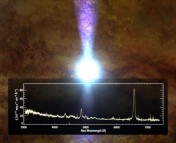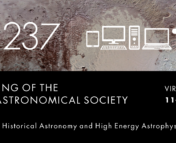A report from the National Astronomy Meeting

This year at the National Astronomy Meeting – the Royal Astronomical Society’s annual conference – something new happened. For the first time, astronomers sat down to talk about the climate crisis. The lunch session hosted by the grass-roots organisation Astronomers For Planet Earth was a sobering call to action that, in the context of a meeting discussing the future of astronomy, highlighted how little we talk about the inevitable change that will happen, and how much we need to prioritise a sustainable course of action.
Speakers included Robert Massey, Deputy Executive Director of the RAS, Tim Hewlett, an activist representing the climate activist group Scientist Rebellion, Sabrina Sartori from the Atacama Large Aperture Telescope (AtLAST), and Stacey Habergham-Mawson & Emma Smith from the National Schools Observatory. The session covered a lot of ground, beginning with an account of the RAS’s recent carbon audit and future aims, through to developing more sustainable observatories and infrastructure, and how we can use our platforms as science communicators to talk about the climate crisis. I think, however, that many will have left with the strongest impact made by Tim’s honest account of the future of our planet and society.
He told us of impending ecological collapse: a food supply crisis leading to global famine, extreme droughts displacing billions of people, and the triggering of catastrophic “feedback” mechanisms such as the thawing of the arctic permafrost that will force us to a point of no return in rapid climate heating. He challenged our current political framework: the model of economic growth at the expense of everything else and the complete ineptitude of this system to work in preserving a safe climate. He insisted we contemplate these facts: as scientists, we know that we have a wealth of evidence to support this picture, and have done for decades — but little progress has been made as we continue on a self-destructive trajectory, so what gives?
It has to be said that, with this context, the RAS and their action plan was somewhat put to shame. We had just heard that they would commit to net zero carbon emissions by 2050 — a statement that many organisations, and governments, are throwing around. It sounds positive, and proactive; 2050 feels sufficiently distant that there must be time to make the required changes gradually, right? “A 2050 target is a commitment to genocide”, says Tim, “and we should be calling that out on the strongest possible terms. But who contests it?” Evidently, not the RAS or its 4000+ members — at least, not strongly enough to push for more drastic action — and clearly not the astronomy community as a whole. But that community is made up of individuals — you, and I — and we all have to ask ourselves, are we being honest with ourselves and taking appropriate action?
So what, then, can we do? Numerous suggestions came up in this session. Travel for astronomy is part of what makes our field’s carbon footprint so large. Robert discussed persuading research councils and funding bodies to introduce a carbon budget as well as a financial one when asking astronomers to justify their travel plans, to promote low-carbon travel options and reduce that footprint significantly. Stacey and Emma pointed out that as astronomers, we have a long history of effectively communicating science to the public. We can harness that and use our platforms to speak out about the climate crisis; with young audiences, they recommend co-creating meaningful interactions with students, to bridge the difficulty reconciling global and individual experiences which can be one cause of apathy in taking action on climate change. Sabrina presented an alternative view for the future of observatories: AtLAST, still in the design phase, is planned to be the first entirely renewably powered telescope facility, and Sabrina’s team are working on innovative technologies in solar power and hydrogen storage to make this plan a reality. And Tim made a strong argument for mobilising academics in actions of non-violent civil disobedience to hold our avoidant governments accountable and call for the swift and radical change that is required: “What institution, if not the University, can hope to counter this onslaught on truth, or drive sufficiently rapid change? If not you, who?”
Tim has made his talk from NAM available on Facebook, and you can watch it here.
Scientist Rebellion are “scientists and academics who believe we should expose the reality and severity of the climate and ecological emergency by engaging in non-violent civil disobedience.” If you would like to get involved in direct action on the climate crisis with Scientist Rebellion, find out more here https://scientistrebellion.com/
If you read Astrobites, chances are you can get involved with Astronomers for Planet Earth – “a grass-roots movement uniting astronomy students, educators, and scientists around the globe to share their astronomical perspective about the Earth and climate change with the public.” Find out more here! https://astronomersforplanet.earth/join-1
We’d love to hear what you would like to see from our climate crisis series – if you have ideas, please let us know in this google form.
Edited by Graham Doskoch




